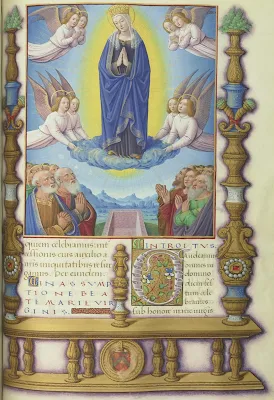While looking for an image earlier this week to go with the notice of the 450th anniversary of St Pius V’s bull Quo primum, which promulgated the Tridentine Missal, I found another really beautiful edition of the Roman Missal on the website of the Bibliothèque National de France. This was made by two illustrators, one named Jean Bourdichon (1457 ca. - 1521), the other an anonymous contemporary of his known as the Master of Claude of France. It was commissioned by Jacques de Beaune (†1511), bishop of Vannes and dean of the chapter of St Gatian in Tours, a member of one of the most prominent families in France. I have here included almost all of the major illustrations, and given a few samples of the minor ones; all of the work throughout the book is of the very highest quality, and shows the strong influence of the Italian Renaissance.
The calendar page for July. Each page of the calendar is decorated with a blue field at the top with the sign of the zodiac that begins in that month (in this case Leo) and below, an image of an agricultural activity typical for that month. The pages with major illustrations have one or two elaborate candlestick decorations at the sides; the writing is typical of the style used by Italian humanists at the time.
The calendar page for July. Each page of the calendar is decorated with a blue field at the top with the sign of the zodiac that begins in that month (in this case Leo) and below, an image of an agricultural activity typical for that month. The pages with major illustrations have one or two elaborate candlestick decorations at the sides; the writing is typical of the style used by Italian humanists at the time.
The Mass of the First Sunday of Advent, with the Mass of St Gregory. This motif will certainly have been chosen because of the tradition that St Gregory composed and set in order all the traditional chants for the Mass, which is commemorated on this Sunday by the singing of the trope Gregorius praesul before the Introit.
Many Masses (more than I can show here) are decorated with an image in a square that fits within the column of text; as a sample, here is the one for the Midnight Mass of Christmas. The book is also filled with illuminated letters of varying degrees of elaboration.
The Day Mass of Christmas
The Circumcision
The Epiphany
Palm Sunday
The beginning of the Canon. Here the artists have broken with the convention of making the first T of Te igitur into a large image of the Crucifixion, but in compensation, have filled the border with the instruments of the Lord’s Passion, including a sarcophagus at the bottom.
Some particularly nice illustrated letters for the names of the Saints in the Communicantes.
Easter Sunday
The Ascension
Pentecost
Trinity Sunday
Corpus Christi
The Conception of the Virgin, represented by the meeting of her parents at the Golden Gate of Jerusalem.
The Purification
The Annunciation
The Visitation
The Assumption
The Nativity of the Virgin
All Saints
Illuminated letters in the common Masses of several Martyrs.
The Requiem Mass
The very elaborate decorative binding, added by a later owner in the mid-16th century.
























